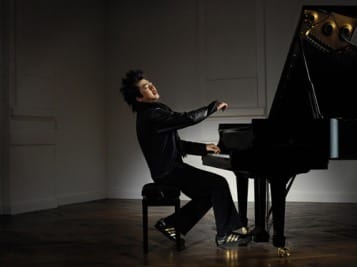- Gathering Note
- Posts
- Review: Lang Lang and the Seattle Symphony
Review: Lang Lang and the Seattle Symphony

Lang Lang is a rare commodity in the world of classical music today. On the one hand, he is a star. Put him on a program with the local symphony orchestra and the house will sell out. His stardom arises from his limitless talent and unorthodox displays of ecstasy, joy, and fitful energy at the keyboard. On the other hand, Lang Lang is an artist conscious of the box stardom could erect around him. Lang Lang’s most recent CD, a program of chamber music, is a first for the pianist. He is also participating in Carnegie Hall’s Chinese music festival performing alongside other musicians from China and on November 10 in a performance with the Shanghai Symphony. Defining this pianist is a difficult proposition. Lang Lang is proving that stardom and artistry can coexist.
A performance by Lang Lang is an annual event in Seattle. He has played alone and with the Seattle Symphony. These concerts stand alone from the regular season and generally sell out. On Sunday, the pianist returned to Benaroya Hall to play Beethoven’s Second Piano Concerto. Gerard Schwarz filled out the rest of the program with more Beethoven – the Sixth Symphony and the Coriolan Overture.
The First and Second Piano Concertos of Beethoven are less known works. The Second, requires dexterity, finesse, and a good sense of humor. Clobbering the keyboard won’t work. The piece is classically shaped, and the concerto’s textures don’t leave room for fudged notes and sloppy playing. if Lang Lang chose this piece to show Seattle he is more than a flashy piano presence, it worked. The concerto begins with a lengthy introduction from the orchestra. Lang Lang, his legs and hands twitching with restless energy, waited patiently until it was his turn. When the music reached the point where the piano enters, he played with cheery abandon, closely matching his own disposition. In the adagio, Lang Lang articulated the meandering sweep of the movement before springing into to the rondo finale. Lang Lang’s fingers danced up and down the keyboard pushing tempos and pouring on the energy and charisma that has made him famous. After several curtain calls, the pianist treated the audience to Chopin’s Op. 25 No. 1 Etude.
Beethoven’s Sixth Symphony, a precursor to the program music that would become synonymous with the Romantic era, was reason enough to venture out to hear the SSO. Even though more than a few people in the audience decided not to return after the intermission, the orchestra stood on its own and gave the audience a beautifully played symphony. The basses and violas were in excellent form. The middle and low ranges reverberated through the hall giving the performance heft. In the stormy fourth movement, the strings pelted the audience with evocative music and timpanist Mike Crusoe, crashed through the sonic rain with thunderous effect.
Commonly, stand alone concerts like Sunday’s matinee are hard on musicians. The soloist, in this case Lang Lang doesn’t get much time to work with the orchestra and the orchestra has to reacquaint itself with music it is only going to play once. At times, these concerts can seem perfunctory and charmless. But when they work, as was the case this past Sunday, they can also conjure a memorable experience music lovers can reflect on long into the season.